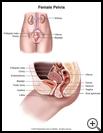
Vaginitis: Teen Version
What is vaginitis?
Vaginitis is the medical name for swelling, burning, itching, or an infection of the vagina. When the vulva are also affected, it is called vulvovaginitis. The vulva are the folds of skin around the opening of the vagina. Vaginitis is a very common problem that can occur in females of any age.
What is the cause?
Vaginitis can be caused by organisms that infect the vagina, such as bacteria, viruses, protozoa, or yeast. It can also be caused by irritants such as soap, powders, or spermicides.
Sexually transmitted infections (STIs or STDs) that cause vaginal infections are:
- trichomoniasis
- chlamydial infections
- gonorrhea
- syphilis
- genital herpes
- human papillomavirus (genital warts)
Yeast infections of the vagina are caused by overgrowth of a fungus called Candida. Vaginitis can also be caused by an overgrowth of bacteria normally found in the vagina. This is a condition called bacterial vaginosis or nonspecific vaginitis.
Irritants that can cause vaginitis include:
- birth control products such as condoms, diaphragms, and spermicides
- feminine hygiene products such as perfumed sprays, powders, or douches
- perfumed soaps, detergents, or fabric softeners
- nonabsorbent, heat-retaining clothing such as nylon pantyhose and tights
- antibiotics
- tampons
- sexual devices
- injury
- objects in the vagina, such as a lost tampon
Vaginitis can also be caused by stress, poor hygiene, or a decrease in estrogen hormone (atrophic vaginitis).
Sometimes the cause of vaginitis is not known.
What are the symptoms?
The main symptom of vaginitis is a lot of whitish, gray, or yellowish discharge from the vagina. Some milky vaginal discharge is normal for females of all ages, but infections usually cause an abnormal amount of discharge.
You may also have:
- a bad, odor from the vagina
- itching
- swollen, red vulva, which may be painful or itchy
- painful intercourse
- bleeding in the vaginal area
- symptoms of a urinary tract infection, such as pain when you urinate
If you have pain in your lower abdomen or irregular bleeding with these symptoms, see your healthcare provider right away. If you are at risk for a sexually transmitted disease and have the above symptoms, you should also see your provider right away.
How is it diagnosed?
Your healthcare provider will examine you and do lab tests. The lab tests may include tests of vaginal discharge, urine, and blood.
How is it treated?
The goal of treatment is to get rid of the organisms or irritants that are causing the symptoms.
Infections are treated with antibiotic pills or shots, antifungal or antibacterial creams or gels, vaginal tablets, or vaginal inserts. Your healthcare provider may ask you to stop sexual activity for a time. Your provider may also ask that your partner be treated to prevent reinfection or spread of the infection.
Vaginitis caused by irritants can usually be treated by stopping exposure to the irritant. Some irritations are treated with steroid or hormone creams.
For women in menopause, vaginal dryness (atrophic vaginitis) can be treated with hormone pills or cream.
Do not treat vaginitis with nonprescription medicine without the approval of your healthcare provider. It could be the wrong treatment.
How long will the effects last?
The symptoms usually start to get better after a day or two of treatment. Infections clear up in about a week. It is very important that you take all of your prescribed medicine, even if your symptoms are gone. This will help to prevent recurrence. If you stop taking your medicine after the symptoms are relieved but before the scheduled end of treatment, the infection or irritation may come back.
How can I take care of myself?
To help relieve the symptoms you can:
- Bathe with nonirritating, unscented soap. Use water that is warm but not hot. Rinse the genital area thoroughly but gently. Pat dry without rubbing.
- Wear loose-fitting, all-cotton underwear or cotton-crotch underwear. Change your underwear every day. Don’t wear underwear when you sleep at night.
- Keep your genital area dry.
- Put nonprescription hydrocortisone cream on itchy or irritated areas.
- Use a vaginal lubricant if you have mild pain during sex.
Call your healthcare provider if you notice a change in color, odor, consistency, or quantity of vaginal discharge.
How can I help prevent vaginitis?
Practice good personal hygiene:
- Bathe daily with mild soap and warm water.
- Wear all-cotton underwear or underwear with cotton crotches.
- Change underwear and pantyhose every day.
- Avoid wearing pantyhose or tights for too many hours, especially in hot, humid weather.
- Wipe from top to bottom (front to back) after using the restroom.
- Use deodorant-free white toilet paper to avoid perfume and dye that might irritate.
- Avoid using feminine hygiene products (such as sprays and powders) and bath additives (such as bubble baths and oils).
- Avoid douching. It is not necessary.
- Use deodorant-free sanitary pads or tampons.
- Avoid spermicidal foams, gels, and creams.
- Have just 1 sexual partner who is not sexually active with anyone else, and practice safe sex.
- Use a condom during sexual intercourse
- If you tend to get a yeast infection when taking antibiotics, use vaginal antifungal creams while you are taking an antibiotic.
Last modified: 2012-01-10
Last reviewed: 2011-09-13

